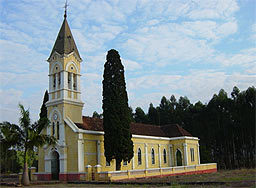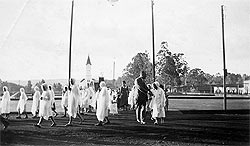 In 1866 the then Baron of São João do Rio Claro, Mr . Amador de Lacerda Rodrigues Jordão, built a chapel paying homage to the farm´s patron saint, Saint Gertrude, which was chosen to honour the baron´s mother, Mrs. Gertrudes Galvão de Oliveira Lacerda. This first construction was done using a rudimentary form of construction "pau a pique", which consisted in pressing clay mixed with straw inside a structure made of wood which would be dismantled after the clay dried, forming a wall. Also on this date the "ara stone" - a marble square containing a relic which consecrates the altar - was brought to the farm, along with a small statue of Saint Gertrude. These two are the only remaining objects of that time.
In 1866 the then Baron of São João do Rio Claro, Mr . Amador de Lacerda Rodrigues Jordão, built a chapel paying homage to the farm´s patron saint, Saint Gertrude, which was chosen to honour the baron´s mother, Mrs. Gertrudes Galvão de Oliveira Lacerda. This first construction was done using a rudimentary form of construction "pau a pique", which consisted in pressing clay mixed with straw inside a structure made of wood which would be dismantled after the clay dried, forming a wall. Also on this date the "ara stone" - a marble square containing a relic which consecrates the altar - was brought to the farm, along with a small statue of Saint Gertrude. These two are the only remaining objects of that time.
In 1897, when the farm was already in the hands of Eduardo Prates, soon to become the Count of Prates, a bigger church was built using clay bricks.
This new building, which was completed in 1898, was done by an Italian contractor and his team and perhaps due to this fact or by order of the Count, the architecture became influenced by European style with pillars; gothic influences on the doors and windows arcades and on the main altar.
The church, at the end of the XIX century and beginning of XX century, besides supplying people with spiritual support was also important on the workers social lives. On Sundays, which was and still is the main leisure day, the day began with mass and only after this religious obligation was accomplished the workers enjoyed their free time, visiting friends and relatives and going shopping. Besides, the holy days, with masses, processions and other solemn festivities, marked their social lives seeing that they constituted at the same time a form of leisure, means of social interrelation and religious expression, being it a typical trace of a rural society that effectively finds in religion an expression of authentic fun and leisure. Therefore, religious life occupied a substantial part of the workers social life, being the priest the central figure of this segment.
A fundamental difference must be considered between the position of the priest or chaplain in the rural life of the Northeast and of thye coffee regions, speacially in Santa Gertrudes Farm. In the Northeast the chaplain escaped the church's dominance to become a sort of servant to the Sugar Cane Mill Owner, in this sense his presence was permanent at the farm and his work was aimed basically at attending the owner's interest who were the then dominant ones. In a way the same thing repeated itself in the Paraíba Valley, although priests did not reside at the farms, all their work was intended at maintaining the slavery system.
When it comes to Santa Gertrudes Farm, since the reconstruction of the church the priests who attended it belonged to Italian orders, first Scalabrinians, then Stigmatinians. Just like in all the coffee producing zone, the priest did not live in the far but his presence was a constant. Contrary to what was then common, here his functions were ambivalent; on one hand, he ensured the spiritual assistance of the catholic workers, the majority of them were Italian immigrants, a fact that made it easier for them and it can be inferred how important it must have been to these immigrants the fact that they could work at a farm that had a church that could provide them with the same service, sometimes better, they received in the great churches of their homeland and still be spiritually served by same origin priests. On the other hand, the boss, a Vatican Count, was being served accordingly to his status. But, the more important was that in caring for the workers, specially the Italians, the priest served as an element that guaranteed the workers fixation at the farm.
During Holy Week it was easy for the Farm to concentrate 2, sometimes even 3 priests to stay for the whole week at the farm. This is due to the fact that at that time the Holy Week represented for them an opportunity of extra work and, Santa Gertrudes farm, besides treating priests excellently, paid their services well. In 1925 it was paid " for the celebration of masses and gratification to the priests by their service during Holy Week - Rs 500$000 ( Five Hundred Thousand Reis - Being One Thousand Reis the currency unit)", quite a large sum if we take into account that the yearly gross income of a worker would be something around Rs 1:000$000 ( A Thousand Thousand Reis).
Besides that, the zeal of a priest at the occasion was measured by the number of confessions and communions, and certainly, at Santa Gertrudes Farm, this was already guaranteed because there would be up to 500 of each at the great festivities.
According to Cândido Procópio F. de camargo, the Traditional Rural Catholicism of Brasil, in which the Catholicism of Santa Gertrudes Farm should be included, compromises diverse elements, whose relation with the components of the religious life of the property not always coincide.
Therefore, when it comes to religious values and their identification to the inclusive society, Santa Gertrudes Farm reveals itself as a finished expression of this relation, mainly when you take the catholic origin of most of the workers, the catholic tradition of the own farm, allied to a situation of moving of the immigrants and seached in religion an orientation of life, capable of orienting this new condition.
As for the reflexes of the social structure in the religious collectivity, the farm presented itself in an incomplete form as only two stratums were distinguished through the distribution of places occupied during the religious practices: the owners, on the left side of of the main altar, in Austrian chairs; employees on the nave in collective wooden benches. It must be observed that it was not verified any distinction among the workers.
When it comes to the linking of religious values to the social life, especially in the leisure activities, it has been noticed the close relation of them in Santa Gertrudes Farm. The whole life of the worker, and the owners when present, had the holy time marking it, for example Sundays and Holydays, when mass was the most important event of the day was also used for visits, trade, games, etc. Processions, beside the intrinsic religious character, allowed parallel activities, the meetings for preparation, the procession itself and the talks at the end of them.
On the days that were considered holy only employees whose jobs had no way of not being done worked. On Christmas Eve, January 1st, Halleluiah Saturday, and Tuesday of Carnaval the work stopped at midday.
June parties were celebrated with both religious and profane activities. In the morning there was a sung mass, in the afternoon, procession. There were also fireworks, barbeque and drinks distributed to the workers by the farm.
When it comes to collective prayers and saint's celebrations, in Santa Gertrudes Farm the regular calendar was observed, except the festivities of the Holy Cross and Saint Gertrude whose inclusion was due to the presence of the Stigmatinian Priests and to the patron saint respectively.
At Santa Gertrudes Farm prayers and processions linked to nature's phenomena were done, especially during the great droughts.
However, many of the elements of the traditional rural Catholicism did not exist at the Farm. As it has been seen, the priest was constantly at the Farm, besides, there was the sacristy person that attended to the services of maintenance of the chapel and accompanied the religious works. This way, there was not the opportunity for common people to assume any form of religious leadership.
As for the empty liturgical and sacramental content of religious practices, in Santa Gertrudes Farm the opposite happened because the ceremony corresponded to that of a Mother Church, and in relation to others, it was more refined and in this sense the church surpassed the ideal standard.
Masses were celebrated every Sunday and in some occasions on the 1st and 3rd Sundays of the month. On holy days masses were sung in the morning with a procession in the afternoon. On Christmas there was a mass at midnight and then again in the morning when sometimes First Communion was celebrated.
The observance of the Cult of the Souls happened in the Farm just in part. Masses celebrating the seventh and thirtieth day after the death of members of the owner's family happened, on such occasions the presence of employees was made compulsory. However, there are no references to such celebrations to workers or their family members, probably due to the fact that this type of celebration does not happen either on Sundays or holy days, only days when masses happened here at the farm. As for the domestic cult of the souls, nothing has been observed.
celebrating the seventh and thirtieth day after the death of members of the owner's family happened, on such occasions the presence of employees was made compulsory. However, there are no references to such celebrations to workers or their family members, probably due to the fact that this type of celebration does not happen either on Sundays or holy days, only days when masses happened here at the farm. As for the domestic cult of the souls, nothing has been observed.
Procession passing through the Terraces - Church on the back. Circa 1930.